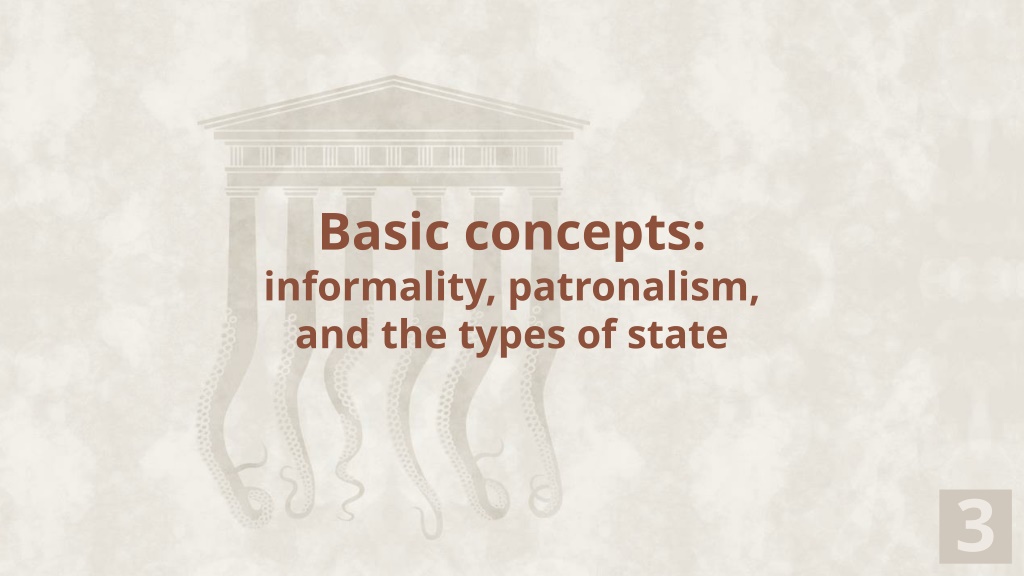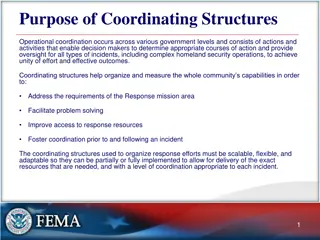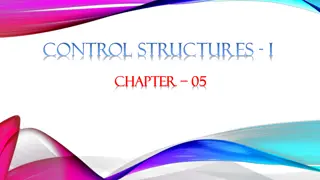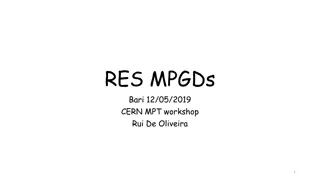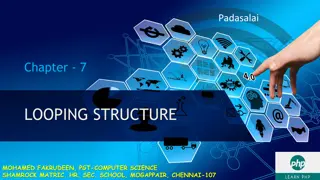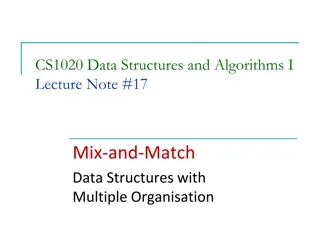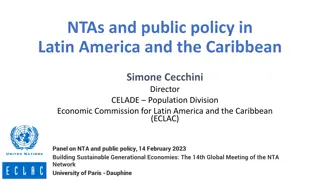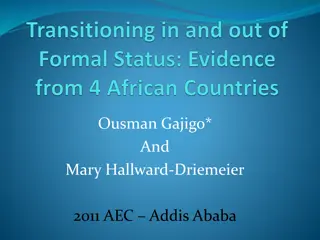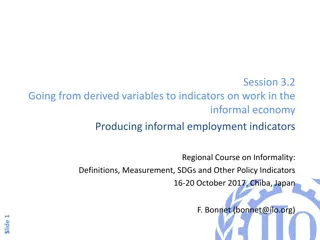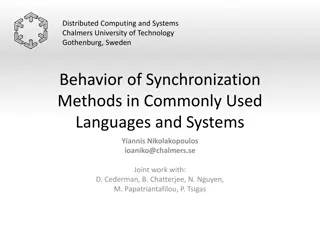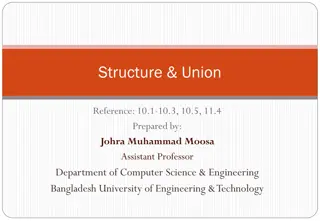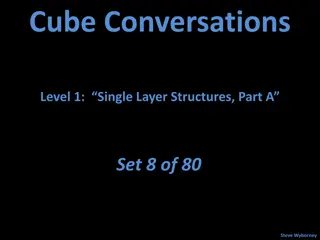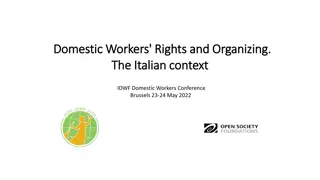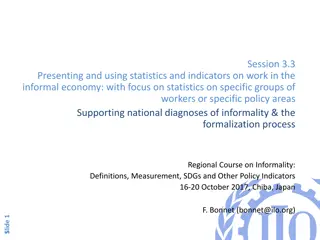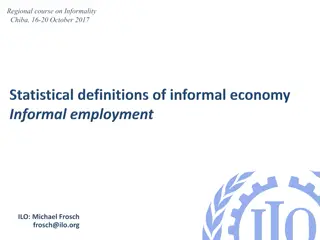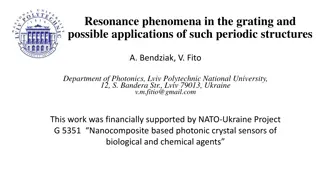Understanding Informality and Patronalism in State Structures
Political regimes are shaped by informality and patronalism, impacting the dynamics between ruling elites and the state. Informality refers to unwritten social rules, while patronalism involves patron-client relationships in a hierarchical pyramid structure. These concepts influence state functioning, elite interests, and societal dynamics. By examining these principles, we gain insight into how power is wielded and resources are managed within different state types.
Download Presentation

Please find below an Image/Link to download the presentation.
The content on the website is provided AS IS for your information and personal use only. It may not be sold, licensed, or shared on other websites without obtaining consent from the author. Download presentation by click this link. If you encounter any issues during the download, it is possible that the publisher has removed the file from their server.
E N D
Presentation Transcript
Basic concepts: informality, patronalism, and the types of state 3
Ruling elite and state in the three polar type regimes Liberal democracy Patronal autocracy Communist dictatorship limited political elite adopted political family nomenklatura non-patronal network informal patronal network bureaucratic patronal network RULING ELITE multi-pyramid system single-pyramid system single-pyramid system dominance of formal institutions dominance of informal institutions dominance of formal institutions state subordinated to the principle of societal interest competitive, deliberative reconciliation of interests transparent/regulated cooperation and connections between public and private spheres state subordinated to the principle of elite interest realizing elite interest at the expense of societal interest state subordinated to the principle of ideology implementation forcibly imposed postulated interest PRINCIPLE OF STATE FUNCTIONING non-transparent / informal collusion of public and private spheres subordination of private sphere to public sphere conflict of private and public interests fusion of private and public interests repression of private interests mafia state (clan state + neopatrimonial/neosultanistic state + predatory state + criminal state) constitutional state party state STATE CONCEPTS separation of powers connected powers merger of powers
Definitions of regime and state Political regime (or simply regime) is an institutionalized set of fundamental formal and informal rules structuring the interaction in the political power center and its relation with the broader society. State is the institution by which the ruling elite of a people exercises the monopoly of legitimate use of violence to extract, manage and distribute resources within the borders of a certain territory.
Definitions of informality and patronalism Informality is a characteristic feature of a social connection and refers to not having a legal and openly admitted form. In other words, an institution that is, a humanly devised constraint that structures social interaction is regarded formal if its rules are not written down and are not made openly accessible to the majority of the population (therefore its rules may or may not be congruent with effective law). Patronal ruling elite is a ruling elite where the members are connected, formally or informally, through patron-client relations. The patronal ruling elite takes a pyramid-like structure of obedience (single-pyramid system), every member being part of a hierarchy subordinated to the chief patron.
Ruling elites in three ideal-type political regimes Constrained political elite (as in liberal democracy) Adopted political family (as in patronal autocracy) Nomenklatura (as in communist regime) non-patronal network informal patronal network bureaucratic patronal network multi-pyramid system single-pyramid system single-pyramid system dominance of formal institutions dominance of informal institutions dominance of formal institutions
Dominant Principles of State Functioning Personal-wealth accumulation (aiming at using power for personal enrichment) Power monopolization (aiming at exclusively possessing political power) Ideology (aiming at using power to realize values) Principle of societal interest X - - - X X Principle of elite interest Principle of ideology implementation X X -
States subordinated to societal interest or ideology implementation Welfare states (providing public services) Night-watchman state (police, courts, national defense) Developmental states (active economic role) Conservative welfare state (family-based social insurance) Liberal welfare state (means-tested benefits) Social dem. welfare state (universalistic services)
Conceptualization of States Running on Elite Interest Alternative terms used for the description of patronage in post-communist regimes The basis for the term used 1. Actor network / patronal / clan state patrimonial / sultanistic / neopatrimonial / neosultanistic state 2. Action (targeting state institutions) rent-seeking / kleptocratic / predatory state 3. Action (targeting property) corrupt / captured / criminal state 4. Legality
What is the nature of the ruling elite? Interpretative layers of categories to describe patronage regimes The type of state To which features of the state the category refers to Interpretive layers of the category Monopoly on the right to authorize the legitimate use of violence Institution by which the ruling elite exercises legitimate use of violence 1. State 1st feature + increasing informal character of the connections within and between the units of the state The ruling elite s exercising power through mainly informal power network 2. Network state 1st + 2nd features + the personal, patronal, hierarchically dependent character of the ruling elite The ruling elite s internal dependency, patron-client relations (patronal power network) 3. Patronal state 1st + 2nd + 3rd features + the political- economic clan (adopted political family) structure of the ruling elite The ruling elite s anthropological structure and cultural patterns 4. Clan state
What is the action for elite-interest based appropriation of state institutions? Interpretative layers of categories to describe patronage regimes The type of state To which features of the state the category refers to Interpretive layers of the category Monopoly on the right to authorize the use of violence Institution by which the ruling elite legally uses violence State 1. Patrimonial state 1st feature + self-interested ruling elite aiming at the private appropriation of governmental sphere 2. Treatment of society as a private domain 1st + 2nd features + operation in an environment of no constraints Total arbitrariness in treating society as private domain Sultanistic state 3a. Patrimonial rule operating in a new institutional setting (where democratic institutions have a moderate constraining effect) Neopatrimonial state 1st + 2nd features + operation in a democratic institutional setup 3b. Sultanistic rule operating in a new institutional setting (where democratic institutions have no constraining effect) Neosultanistic state 1st + 2nd + 3brdfeature + the democratic institutional setup is purely instrumentalized 4.
What is the action for elite-interest based appropriation of property? Interpretative layers of categories to describe patronage regimes The type of state To which features of the state the category refers to Interpretive layers of the category Monopoly of taxation (tax, rent, etc.) for maintaining public functions 1. State Primary source of state revenues Favoritism to expand state bureaucracy/enterprises for the ruling elite and its beneficiaries Rent-seeking state 1st feature + legal overtaxing in favor of the ruling elite and its beneficiaries 2. Kleptocratic state 1st + 2nd features + illegal diverting of current incomes to private hands 3. Illegal favoritism 1st + 2nd + 3rd features + expropriation of non-monetary property using illegal state coercion 4. Predatory state Illegal predation
What is the legal status of the elite-interest based action? Interpretative layers of categories to describe patronage regimes The type of state To which features of the state the category refers to Interpretive layers of the category Monopoly of taxation (tax, rent, etc.) for maintaining public functions 1. State Primary source of state revenues 1st feature + the abuse of entrusted power for private gain (occasional, non-stable chains of vassalage) Corruption = deviant element of the system 2. Corrupt state 1st + 2nd features + chains of corrupt vassalage with a permanent character Corruption = structural element of the system 3. Captured state 1st + 2nd + 3rd features + subordinated to and monopolized by a political enterprise (governance led as a criminal organization) Corruption = constituting element of the system 4. Criminal state
State Functions Subordinated to Private Interests: the Post-Communist Mafia State Alternative terms used for the description of patronage in post- communist regimes The basis for the term used 1. Actor clan state 2. Action (targeting power) neopatrimonial / neosultanistic state mafia state 3. Action (targeting goods) predatory state 4. Legality criminal state
Comparing mafia state to constitutional state: the amplitude of arbitrariness level of collusive corruption maximum amplitude of arbitrariness criminal state captured state corrupt state negative positive state nature of state intervention nature of state intervention D3 D1 D2 D1 N D3 D2 Legend: N: normative intervention D1: discretional intervention as non-structural deviation Note: the dotted lines are added lines for the sake of clarity. D2: discretional intervention as structural deviation D3: discretional intervention as constitutive element
Violence Managing Agencies Strong state Criminal state Normal state Captured state Public Corrupt state Weak state* State Failed state Illegal public use of violence (informal state roofs ) Legal public use of violence (formal protection) Illegal Legal Legal private use of violence (private protection agencies) Illegal private use of violence (criminal groups) Security guard Criminal protector Criminal protection group Security service Private Security company Criminal protection racket Private police Warlord *: Not failed
Relations between violence-managing agencies (agents) of different status Illegal-public users of violence Illegal-private users of violence Legal-private users of violence Legal-public users of violence correspondence fight / informal collusion legal franchising Legal-private users of violence legal franchising / informal collusion fight / informal collusion n.a. Illegal-private users of violence illegal franchising n.a. n.a.
Types of state by dominant extra- market means and interaction with property owners Invisible-hand model (violence-managing agencies dominantly take over (1) monetary property (2) to maintain its own functioning) Helping-hand model (violence-managing agencies dominantly take over (1) monetary property (2) to promote societal interest / ideology) Welfare state Grabbing-hand model (violence-managing agencies dominantly take over (1) non- monetary (and monetary) property (2) to promote ideology / elite interest) Mafia state (predatory state) Party state Normative state intervention Discretional state intervention (using public institutions in a coordinated manner) Discretional state intervention (using public institutions in an uncoordinated manner) Dominant extra-market means
